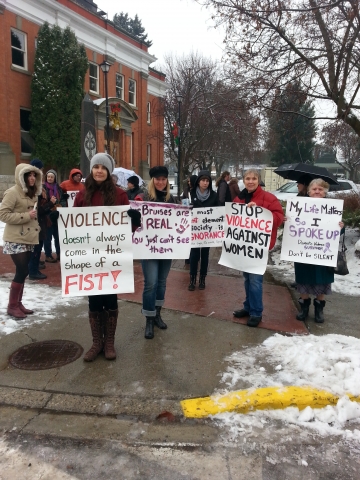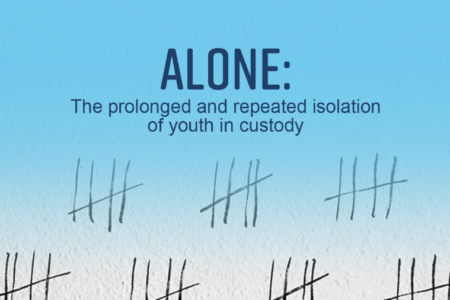National Day of Remembrance provides opportunity for community dialogue on domestic violence
On Dec. 6 from 10 a.m. until noon, over 25 men, women and children gathered in Grand Forks for the National Day of Remembrance and Action on Violence Against Women, informally known as White Ribbon Day. The Boundary Women’s Resource Centre Program Manager Teresa Taylor organized the event, with help from transition house staff and collective directors. “It was an amazing turnout, “ said Taylor, “One of our best ever!
Joining with thousands across the country, the group came together to raise awareness of violence against women and to commemorate the 25th anniversary of the 1989 École Polytechnique massacre, in which armed student Marc Lépine murdered fourteen women and injured ten others in the name of “fighting feminism.”
Meeting in the rain and slush by the lowered flag in front of City Hall, Taylor and Stopping the Violence counsellor Stephanie Koorbatoffspoke the names of the women that died in Montreal. Eighteen red carnations, representing people in BC who have died as a result of domestic violence were handed out and then placed on the Cenotaph in remembrance.
Following a moment of silence, the group marched to Kocomos Coffeehouse bearing anti-violence signs. Special thanks to Tom and Susan at Kocomos for providing the group a warm, dry space and service with a smile. Latecomers were welcomed in to listen to local favourite Kyra Hogan sing two songs, accompanied by her acoustic guitar.
An enthusiastic, thought-provoking discussion followed on the roots and realities of violence and how we can build peace in our communities through things like mentoring, changing our language, and teaching children words for nonviolent communication.
“People were really engaged in generating ideas about how not to be just a silent bystander,” said founding Boundary Women’s Collective member Diana Carr.
The impact of privilege on the cycle of violence was also brought up, with a challenge for everyone to write down everything that his or her privilege impacts i.e. “check your privilege”. If you are interested in trying this exercise, click HEREfor some online privilege lists.
Collective director Rae Coleman commented, “It was so nice to see some new faces and hear a diverse group of people come together and explore potential solutions for addressing violence towards women.” Everyone contributed to the dialogue in a meaningful way and expressed appreciation for the opportunity to share their voice. As Hogan’s mom Kristina Hockley so aptly posted on Facebook, “[It] seems especially important to be aware of at the moment and to share the burden of change so that we can all live a more peaceful existence.”
Definitions and statistics
The United Nations defines violence against women as “Any act of gender-based violence that results in, or is likely to result in, physical, sexual or mental harm or suffering to women, including threats of such acts, coercion or arbitrary deprivation of liberty, whether occurring in public or in private life.”
United Nations Secretary-General Ban Ki-moon has stated “Violence against women and girls continues unabated in every continent, country and culture. It takes a devastating toll on women’s lives, on their families and on society as a whole. Most societies prohibit such violence – yet the reality is that too often, it is covered up or tacitly condoned.”
Here in Canada, there have been 6551 female homicide victims between 1980 and 2012, averaging 615 per year. Of those homicides, 1103 occurred in BC.Every year over 60,000 physical or sexual assaults occur against women in BC, over 1000 every week – the majority committed by men. Over half of BC women have experienced physical or sexual violence since the age of 16, totalling more than one million women in our province.
One in three women will be sexually assaulted in her lifetime. Police-reported aggravated sexual assault in BC rose 9% in 2013; however, only 12% of sexual assaults against women are reported to police.
According to Stats Canada 2012 saw 16,259 police-reported survivors of intimate partner violence (IPV) in BC, significantly higher than the Canada-wide rate. A 2014 study by the FREDA Centre for Research on Violence Against Women and Children indicates domestic violence (DV) and sexual assault (SA) are increasing despite an overall decline in reported violent crimes across Canada. BC is reportedly seeing its highest rates of domestic violence in seven years.
According to Maurine Karagianis, NDP spokesperson for Women, Seniors, and Early Childhood Development in BC, there have been at least 20 deaths related to domestic violence, including 18 women, one man and one child. None of the women killed this year reported violence in their homes. These stats do not include those seriously injured or, of course, unreported cases.
For a brief chronology of domestic violence murders & attempted murders and suicides in BC between Jan and Sept 2014, click here: http://endingviolence.org/wp-content/uploads/2014/02/3_Backgrounder_for-Sept3_vF.pdf
Violence towards Aboriginal and immigrant women
Victimization rates are much higher among Aboriginal women, with 24% percent reporting they had been victims of domestic violence between 1999 and 2004. Aboriginal women often reported the severest types of violence, including sexual assault, beatings, choking, and threats with a weapon. Geographic isolation, lack of access to services, lack of transportation, and poverty heighten risk for Aboriginal women.
There have been 1,181 police-recorded incidents of aboriginal homicides and unresolved missing aboriginal women investigations in Canada over the past three decades. In May RCMP released the National Operational Overview on Missing and Murdered Aboriginal Women. The study found that aboriginal women made up 4.3 per cent of the Canadian population, but accounted for 16 per cent of female homicides and 11.3 per cent of missing women. More than 90 per cent of these murder victims knew their killer. Eighty-nine per cent of the offenders are male and their average age is 35.
BC has the highest number of unsolved cases related to aboriginal women, with 40 missing women cases and 36 unsolved homicides reported in the study.
Immigrant women are another highly vulnerable group due to social isolation, lack of information about rights and available services, lack of English skills and multilingual services, immigration and sponsorship issues, poverty, and lack of support from their cultural community.
BC Lions and More Than a Bystander
A recent collaboration between Ending Violence Association of BC (EVA BC) and the BC Lions Football Club has produced a short documentary that presents a fresh look at gender violence that engages men and boys as allies and encourages them to be more than bystanders. The Be More Than a Bystander program and film aim to increase understanding of the impact of domestic and sexual violence in the lives of women and girls, and on the community as a whole.
In the film, BC Lions players share personal stories about how they engage with the issues, both through personal reflections and in their interactions with youth in schools and events throughout the province. Feminist anti-violence experts and community advocates offer their analysis and a broad framework for understanding why violence against women is a men’s issue. The film is being distributed to schools and anti-violence programs across BC. It is also available for purchase. For more details, please email evabc@endingviolence.org or call 604-633-2506.
You can watch more More than a Bystander on Shaw Video on Demand and TELUS Optik TV
For Shaw:
Method 1) go to the Shaw VOD Button on the remote, go to TV On Demand, then to Shaw TV, and then Shows
Method 2) go to VOD and search “Bystander”
Method 3) if you are a Shaw customer, you may view the film on your computer by going to vod.shaw.ca, and search “Bystander”
For TELUS Optik TV: go to TV On Demand, then to Optik Local, then to Featured. It is also in the Documentary section on the TELUS Network.
Further resources
In March 2012, BC established the Provincial Office of Domestic Violence as the permanent lead for province in coordinating and strengthening services for those affected by domestic violence. The office is accountable for ensuring the effectiveness and comprehensive delivery of all domestic violence policies, programs and services. It is responsible for monitoring, evaluating and reporting progress, and for consultation with stakeholders to support a coordinated, systemic approach to domestic violence.
If you or somebody you know is being abused, help is available. For more information visit: http://www.mcf.gov.bc.ca/podv/index.htmor http://www.domesticviolencebc.ca/
For more up-to-date news, videos and other resources from EVA BC go to:
http://endingviolence.org/category/in-the-news/
Provincial Office of Domestic Violence
British Columbia’s Provincial Domestic Violence Plan
http://www.mcf.gov.bc.ca/podv/pdf/dv_pp_booklet.pdf
Toolkit for healthcare professionals
http://www.kpu.ca/sites/default/files/NEVR/DV%20Toolkit%20%20PDF%20August%2024.pdf
— submitted by Michelle Croissant and the Women’s Resource Centre






















